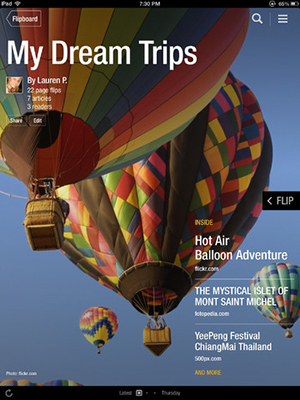Flipboard, the app that calls itself “your social magazine,” introduced version 2.0 on Tuesday. Where the first generation created magazines out of social media feeds, this one allows its users to play a more active role.

“Flipboard just created 50 million magazine editors,” said Poynter’s Jeff Sonderman. I wouldn’t go quite that far (magazine editors do more than curate) but the new Pinterest-esque/Paper.li-ish features make it easy to create your own digital “magazine” out of existing content.
The Guardian is one of the first publications to partner with the new Flipboard (and has been on the app since 2011). It’s rolling out three themed magazines comprised of Guardian content. Guardian US’s senior press officer, Gennady Kolker, told CJR in an email: “The first three magazine subjects were chosen with the intent to provide a range of subjects that showcase the Guardian’s distinctive journalism: a combination of light-hearted, fun and irreverent (Royal Wedding), interesting (Space) and serious (Death Penalty in America).”
The Guardian has been at the forefront of digital news innovations often, so the Flipboard 2.0 pairing is no surprise. Said Kolker: “It reflects our commitment to reach a new and growing community of readers and meet them where they already are … [Flipboard’s] commitment to innovation and the idea of ‘open’ align quite nicely with the Guardian‘s digital-first and open approach to journalism.”
It also has the potential to bring in some much-needed revenue. Though Kolker wouldn’t comment specifically on that, he did say that the Guardian was “looking forward to offering brands and marketing partners a new way to engage with our audience.” Flipboard’s FAQ says it’s “piloting magazine style full-page advertising with a small group of publishers.”
It should be noted that the Guardian‘s last high-profile content-sharing partnership–with Facebook–was a flop. Though early adopters to the social reader app, launched late September 2011, saw big bumps in digital readership at first, Facebook users complained that their feeds were being bombarded with links to news articles that their friends “shared” with them merely by reading them (not to mention that many users didn’t realize what they read was also being broadcast to their friends). Facebook changed its algorithm to make social reader shares less prevalent on newsfeeds and the process of opting out of sharing easier, and readership plummeted. By December, the Guardian announced it would “switch focus” and end the social reader app.
Flipboard 2.0 will show us what the Guardian learned from its first foray into content sharing. The key difference, it seems, is user choice and engagement. Curating content makes Flipboard 2.0 an active experience for the user, who will then, most likely, choose to promote the curations through social media sharing.
“It’s about giving readers choice in how they consume our content on Flipboard,” Kolker said; “Whether they’re curating their own magazines, or flipping through the Guardian‘s magazines, readers can decide what works best.”
Sara Morrison is a former assistant editor at CJR. Follow her on Twitter @saramorrison.
